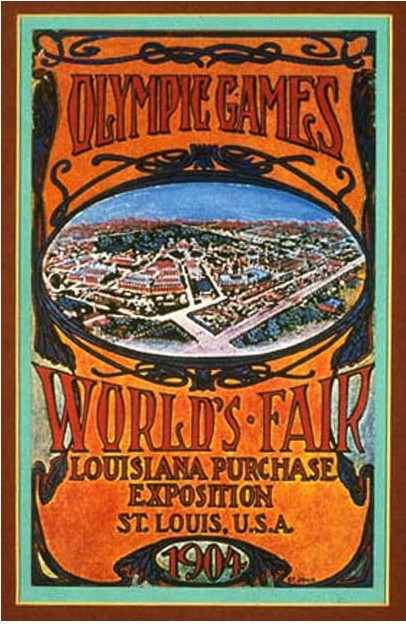
St. Louis is one of the few American cities that can claim it hosted the Olympics. At the games of the III Olympiad in 1904, 651 athletes from eleven nations competed in fifteen sports. It’s a highlight of St. Louis history, but to some historians, it’s considered a low point in Olympic history.
Since moving to St. Louis, I have always heard the 1904 games of St. Louis were somewhat of a joke. I’ve even read they were considered an embarrassment to the modern Olympic movement. The prevailing opinion is that the games were overshadowed by the 1904 World’s Fair in Forest Park, which occurred at the same time. The games were poorly organized, events were spread out over several months, nobody attended, and most of the world’s best athletes didn’t bother to show up.
Drive by Washington University today and you’ll see Francis Field, the stadium that hosted many events, including track & field, gymnastics, and archery. Drive by the corner of Wydown and Skinker and you’ll see the area where the “Life Saving Exhibition Lake” existed. Used by the Coast Guard during the World’s Fair to demonstrate water safety, it also acted as the venue for swimming and diving. The sites are there, but unless you get out and really look around, you will find scant evidence of an Olympic history in St. Louis. I’ve always wondered why St. Louis doesn’t embrace its Olympic history more. And why did St. Louis fail so miserably at hosting the Olympics, but overwhelmingly succeeded at hosting a World’s Fair?
I set out to do a little research and figure out what went wrong at the St. Louis Olympics. Some of the criticisms have merit. Spreading the events out over four months did made it difficult for foreign athletes to get to St. Louis. Organizers also made a mistake in including several levels of competition. High school, college, and even YMCA events were contested, making it difficult to determine which events were considered “Olympic”. However, St. Louis was only the third Olympics held. The prior Olympics in Paris are also considered a disaster, so St. Louis had only one Olympics (1896 in Athens) to build on. Things we take for granted in today’s games, such as opening ceremonies, lighting the Olympic torch, and defined standards for Olympic sports had not yet been defined. A standard protocol for hosting the games wouldn’t be instituted for years.
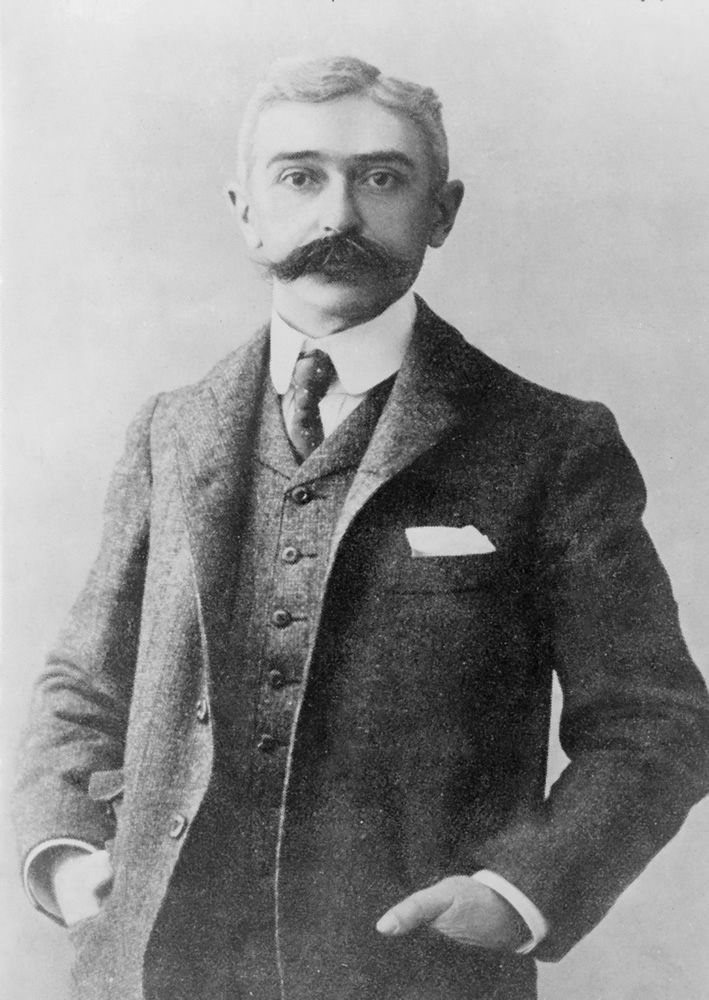
St. Louis actually made some significant contributions to the modern Olympic movement. It was the first Olympics to award gold, silver, and bronze medals. Boxing, freestyle wrestling, and the decathlon made their Olympic debut. It was the first Olympics in which African-Americans competed and medaled.
But the overwhelmingly negative view of the St. Louis Olympics could stem from what it did not have: A man by the name of Pierre de Coubertin.
Baron Pierre de Coubertin is considered by many to be the father of the modern Olympic Games. Largely through his efforts, the first modern Olympics were held in Athens, Greece, in 1896. Eight years later in 1904, the third Olympics were awarded to the city of Chicago. However, the Louisiana Purchase Exposition, the largest World’s Fair ever staged up to that point, was scheduled to occur in St. Louis at the same time. Some key people in St. Louis, notably a man named David R. Francis, didn’t think an international sporting event held in a rival city was a good idea. He wanted to get the games transferred to St. Louis. To do this, he threatened to hold a rival athletic competition at the World’s Fair to directly compete with the Olympics. It was the perfect ploy. The world was already coming to St. Louis, so he held all the cards. The debate created quite an uproar, especially in Chicago, which had already been planning the games for over a year. Eventually, Pierre de Coubertin gave in and the games were transferred to St. Louis.
I recently read a book titled America’s First Olympics: The St. Louis Games of 1904 by George R. Matthews. In this book, I read a side of the story I finally wanted to hear. According to Matthews, Coubertin held a deep grudge for the rest of life in response to being bullied into moving the games. One of his bitter rivals in the athletic community, a man named James E. Sullivan, was named one of the major organizers of the St. Louis games. These facts led Coubertin to become completely uninvolved with the St. Louis Olympics months before they started. He did not attend, nor did he offer any input as to how the games should be run. Later in life, he tried to pass off the decision by claiming President Theodore Roosevelt stepped in and insisted the games be relocated St. Louis. However, George Matthews asserts there is absolutely no evidence to support Coubertain’s claim.
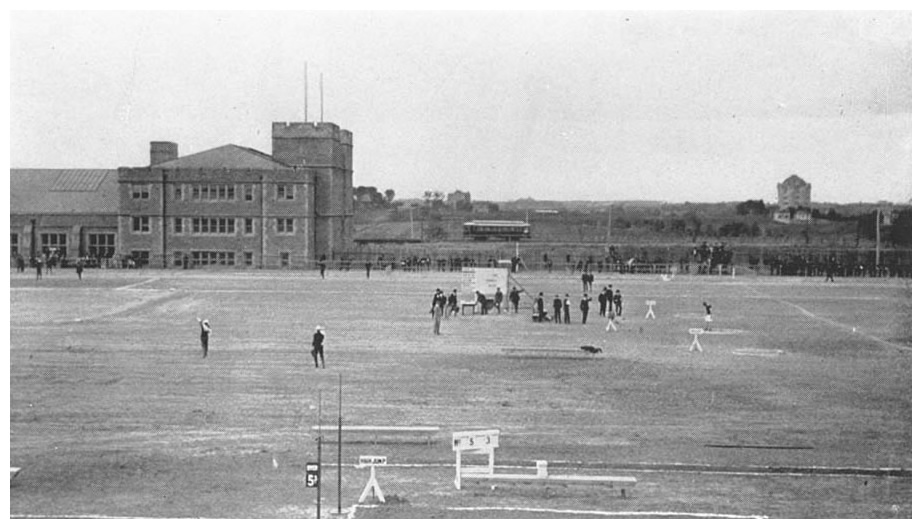
In his book, Matthews claims the St. Louis Olympics should actually be viewed as a success. Newspaper accounts from around the country portray the St. Louis Olympics as being well-organized, competitive, and entertaining. The events were well attended. St. Louis built state of the art facilities for the time. At the conclusion of the games, Pierre de Coubertin even wrote a letter of congratulations to David Francis for hosting a successful Olympic games.
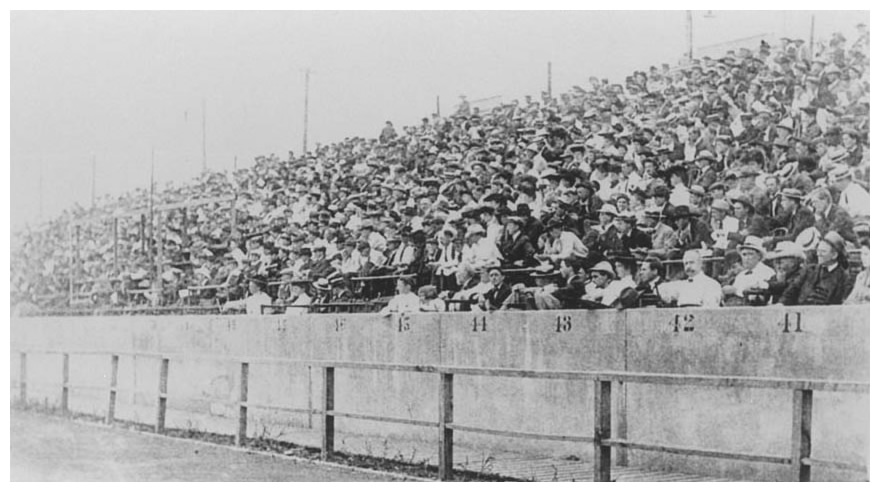
The St. Louis Olympics did have its low moments. Since it was difficult to travel to the middle of North America at the time, the overwhelming number of athletes were from the United States. Many events, such as water polo, are not officially recognized by the International Olympic Committee today because only American teams competed. Coubertin harshly criticized the “World Anthropological Days”, in which indigenous peoples competed in sporting events as a source of entertainment. Although not part of the Olympic program, hosting the events in conjunction with the Olympics conveys the racist attitudes of the time . The marathon, although probably considered a debacle, is perhaps one of the most comical events in Olympic history (click here to read more about that crazy day).
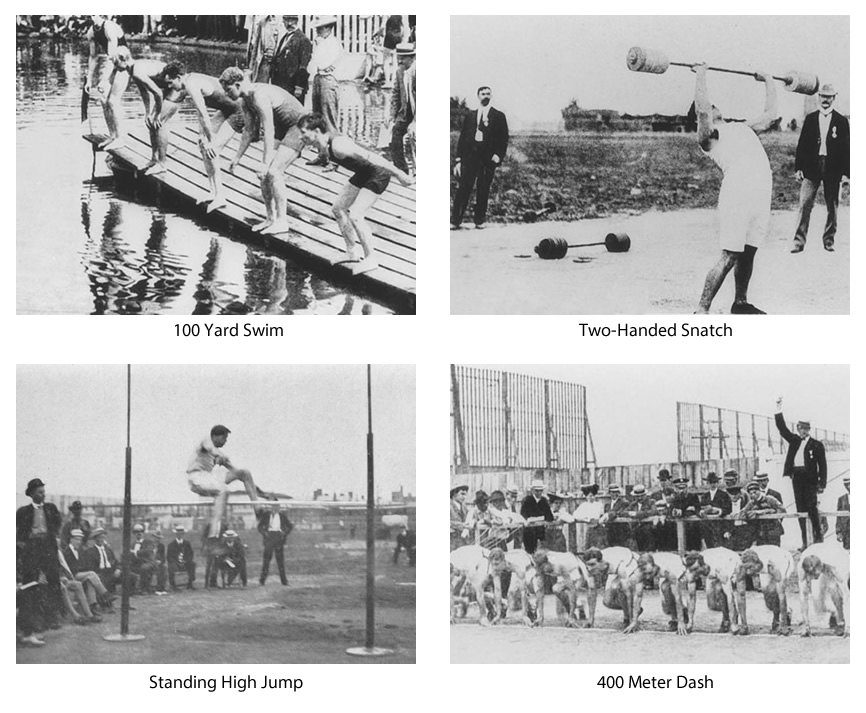
It is a fact that St. Louis was soon overshadowed by games held in subsequent Olympiads. London in 1908 and Stockholm in 1912 were much bigger and benefited from learning the mistakes made in previous Olympics. But according to George Matthews, the real damage to the memory of the St. Louis Olympics started in 1931. This is when Pierre de Coubertin published his memoirs. In this book, Coubertin paints the St. Louis Olympics a being complete failure.
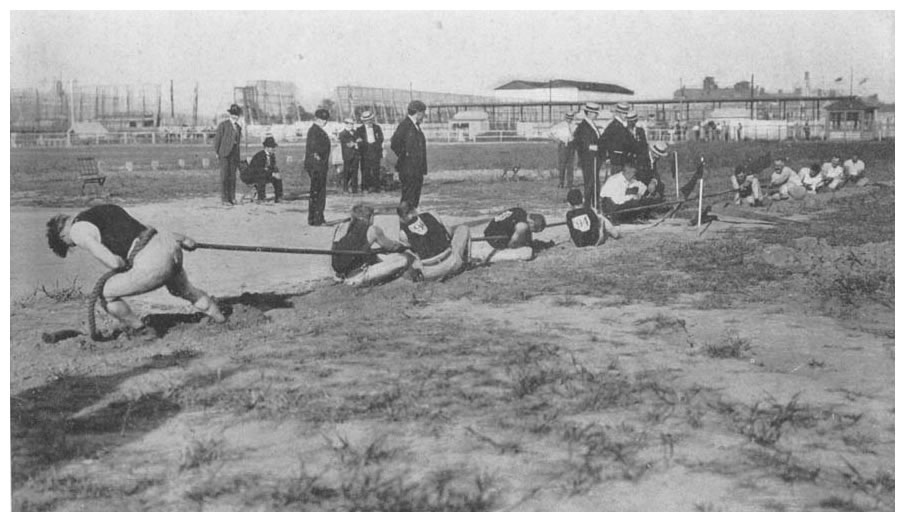
Coubertin’s book was the first written account of the St. Louis Olympics. In it, he trashes an Olympics he never set eyes on. Coubertin attacks on several fronts. First, he voices a displeasure for the city of St. Louis (which he visited only once in 1893). Second, he states that he was forced by Roosevelt to transfer the games (again, there is no evidence to support this claim). Finally, he claims the Olympics were merely an appendage to the World’s Fair. By 1931, anyone of note who could counter his claims (such as Theodore Roosevelt) had passed away.
Further damage to the memory of the St. Louis Olympics was done in 1948 when a man named Bill Henry published The Approved History of the Olympic Games. Henry’s assessment of the St. Louis Olympics is even harsher. He calls the them an “embarrassment” and questions if any event contested in St. Louis should be considered Olympic. He argues that world-class athletes purposely skipped the games and that most of America had no idea the Olympics were even happening in St. Louis. Matthews adroitly counters these claims sufficiently in his book. Henry also completely fabricated events such as Theodore Roosevelt’s daughter Alice placing a wreath on the marathon winner’s brow. In fact, Alice Roosevelt wasn’t even in St. Louis on the day the marathon was contested. In fact, the word “Approved” in the title of Henry’s book means just that. Along with offering assistance with Henry’s research, Pierre de Coubertin had had given his approval of the manuscript shortly before his death.
Obviously, Matthews is just one voice in this small debate. However, after reading his book, It’s impossible to not have a greater appreciation for the St. Louis Olympics. Although Coubertin is certainly an important figure in Olympic history, I believe it’s likely he was a man who took credit for what worked and avoided blame for what didn’t. Unfortunately, many historians continue to follow his lead. Renowned Olympic historian David Wallechinsky claims in his Complete Book of the Olympics 2012 that the poor organization in St. Louis nearly ended the modern Olympic movement. I’ll have to keep up the research on this question. There’s more to this story.
 By the length of this post, a reader can likely determine I’m a big fan of the Olympics. I am happy to say I’m one of the few that can claim to have been in Lake Placid at the moment the USA beat the USSR in hockey in 1980. Sounds great, but I was actually only nine years old at the time. I was stuffed inside a pillowy snowsuit and forced to waddle around downtown Lake Placid like Ralphie’s little brother in A Christmas Story. In all honesty, the noise and drunk crowds at the moment of celebration scared the living shit out of me. As a result, I perfectly remember pissing my snowsuit when Lake Placid erupted in celebration. Still, the experience was so unique that I’ve been an Olympic fan ever since.
By the length of this post, a reader can likely determine I’m a big fan of the Olympics. I am happy to say I’m one of the few that can claim to have been in Lake Placid at the moment the USA beat the USSR in hockey in 1980. Sounds great, but I was actually only nine years old at the time. I was stuffed inside a pillowy snowsuit and forced to waddle around downtown Lake Placid like Ralphie’s little brother in A Christmas Story. In all honesty, the noise and drunk crowds at the moment of celebration scared the living shit out of me. As a result, I perfectly remember pissing my snowsuit when Lake Placid erupted in celebration. Still, the experience was so unique that I’ve been an Olympic fan ever since.
What better drink to celebrate the Olympics, particularly the start of the London 2012 Olympics, than the overwhelmingly English quaff Pimm’s. I’ve always wanted to find a good recipe for it’s most popular product line, Pimm’s No. 1.
Pimm’s is a gin-based liqueur containing quinine and a mixture of herbs. It was created by a man named James Pimm, the owner of an oyster bar in London. In 1823, he created and offered a digestif named “Pimm’s Cup”. It soon became very popular among visitors to his bar. Large scale production of Pimm’s started in 1851 and then commercially in 1859. After being relatively unknown in the United States through the 20th century, it’s popularity has significantly increased in recent years. In England, it remains overwhelmingly popular. Along with champagne, it is one of the two signature drinks at Wimbledon.
Pimm’s is most commonly served as a fruit cup. It’s usually mixed with lemon juice or ginger ale. Fresh ingredients, such as cucumber, lemon, strawberry, and mint are commonly mixed in to add to the spicy flavor of the liqueur. It has a low-alcohol content (50 proof), so it’s perfect for drinking a few glasses while watching several hours of London 2012 Olympic coverage.
I found this recipe in Bon Apetit magazine and set out to make it myself and drink it through London’s opening ceremonies.


I had a bit of fun finding the ingredients for this drink. My hometown of Elmira, New York, where I am on vacation, isn’t exactly a shopper’s paradise. I had no luck finding ginger beer, so I went with a premium ginger ale. I also have to admit I had no idea what a rhubarb looks like. For some reason, I expected it to look like kale. I can only hope my culinary skills improve as my mixology skills do. A great treat was my mother’s herb garden, which provided the fresh rosemary, thyme, and mint.
(Update: After reading this post, my friend Gina pointed out that I shouldn’t say “a rhubarb”. I should say “rhubarb”. It’s written or spoken as “a stalk of rhubarb”, not as a singular item like “a carrot”. I’m obviously very ignorant about rhubarbs… or stalks of rhubarbs… or whatever.)
Unfortunately, my Pimm’s drinking did not coincide with any Olympic viewing. A rare tornado hit my hometown the night before the Olympics started. Trees were knocked down and uprooted all over the city. Cable and air signals were both knocked out, so we drank our Pimm’s (and later a couple Manhattan cocktails, of course) in front of a black tv screen. There’s nothing better than a bit of alcohol during an outage.
I found the drink very refreshing! It’s very crisp, spicy, and fruity. With the muddled cucumber, I think I’ll someday tinker with the recipe a bit. I love gin (and Pimm’s is gin based), so perhaps a bit of Hendrick’s can add to the flavor. It will be good to drink when I get back to the 100 degree weather in St. Louis.

Is that a bit of rhubarb stalk I see nestled up to the sprig of mint? Did your mother tell you that we had a rhubarb patch on 1st Street? One of your grandmother’s favorite summer treats to make was “strawberries and rhubarb,” a jammy kind of thing served in a bowl, I think maybe with whipped cream. (I was only 8 or 9 at the time.) What I DO remember, tho”, is that I would just pick out all the strawberries to eat. I wasn’t crazy about the rhubarb itself!
That is a rhubarb! I had no idea what I was looking for in the store. I had to ask someone for help. Ha!
This blog is bloody fantastic. Excellent post once again. History and boozy drinks, a better combination there has never been.
Thanks so much! I’m back from vacation, so I should have a couple more Olympic posts coming soon.
I live in University City. For some reason, I am obsessed with the events of 1904 in St. Louis. I gobble up everything that relates to the Olympics and the World’s Fair in St. Louis. They were both absolute messes of which movies could be made. The scant evidence of the Olympic’s existence is about a half-mile from my house on North and South just north of Delmar, it is a U-City road marker:
http://i.imgur.com/vUsdY.jpg
Great blog, keep it up!
Thanks! I can’t get enough of it, either. I could do St. Louis Olympics posts forever. Thanks for reading!